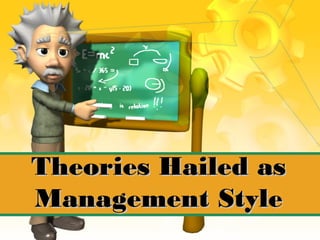
Theories of Management Style
- 1. Theories Hailed asTheories Hailed as Management StyleManagement Style
- 2. Theories of Management 1. Taylorism ( Scientific Management) 2. Fayolism ( Process Approach) 3. The Hawthrone Effect 4. Maslow’s Hierarchy of Needs 5. Complex Man
- 3. Taylorism | Scientific Management *one of the earliest management styles * propounded and developed by Frederic Winslow Taylor in 1900
- 4. Taylorism | Scientific Management *the concept of Scientific Management is also known as “Taylorism” *this method believed in the concept of “One Best Way”, to perform a certain task.
- 5. Taylorism | Scientific Management In general, Taylorism believed in the following principles: 1.Decision-making should be under the purview of the management. 2. Developing a standard method to perform each job.
- 6. Taylorism | Scientific Management 3.Selecting workers with appropriate abilities for each job to create an environment of excellence and complete understanding of the task. 4. Workers to be trained on the standard methods were those previously developed and fine- tunes.
- 7. Taylorism | Scientific Management 5.Provide a complete support to employees so that they can plan their work and eliminate interruptions. 6. In case of increased output by a certain employees, he/she be rewarded with a wage incentive, or bonus.
- 8. Fayolism | Process Approach *second of the early business management styles. *the process approach was propounded by Henri Fayol in the 1920s
- 9. Fayolism | Process Approach *popularly known as “Fayolism”. Fayolism is a modification of Taylorism. *However, the modifications made this management style very different from Taylorism as it was broader in perspective
- 10. Fayolism | Process Approach Fayolism follows 14 principles of administration: 1.Division of work 2.Authority 3.Discipline 4.Unity of command 5.Unity of direction 6.Subordination of Individual Interest to the Common Interest
- 11. Fayolism | Process Approach 7.Remuneration of personnel 8.Centralization 9.Scarlar chain 10.Order 11.Equity 12.Stability of personnel tenure 13.Initiative 14.Esprit de corps (Union is strength)
- 12. The Hawthrone Effect *developed in the 1930s and 1940s, the Hawthrone experiments by Elton Mayo, were the basis of this management style
- 13. The Hawthrone Effect *this management style believed in the concept of: “A happy worker is a good management style. *The management style believed in the concept of: “A happy worker is a good worker”. *majority of the concentration was focused on providing employees with required amenities
- 14. * such as adequate light, healthy diet and conducive environment were provided to the employees to ensure optimum output. *This concept was developed on the basis of two beliefs: 1.People are not the rational and economic being assumed by classical theorists. 2.Social interaction is important and people work well if they feel valued.
- 15. The Hawthrone Effect The Hawthrone experiments were divided in 3 parts. 1. a set of changes were made to the general work environment and timings. 2. conducting interviews with each of the employees 3. checking if incentives had any impact on the productivity of employees
- 16. The Hawthrone Effect The Hawthrone experiments highlighted the fact that human beings were the main resources for many organizations and had to be kept happy to ensure high productivity.
- 17. Maslow’s Hierarchy of Needs *Maslow's hierarchy of needs is a theory in psychology proposed by Abraham Maslow in his 1943 paper "A Theory of Human Motivation"
- 18. Maslow’s Hierarchy of Needs * Maslow’s theory on the ‘Hierarchy of Needs’ had many implications for management style. * According to Maslow, every individual’s need is divided into a certain hierarchy.
- 20. Maslow’s Hierarchy of Needs Maslow’s hierarchy of needs is followed to quite an extent today by many organizations. It is used as a guide for employee satisfaction and general need-allocation in life.
- 22. Complex Man Safety culture was developed because: 1.No single management style could succeed in improving the performance of all workers. 2.The motives of individuals were extremely complex and liable to change over time. 3.A high level of satisfaction did not necessarily lead to increased productivity.
- 23. *As per safety culture, the following factors were pertinent to the safety interest of any organizations: 1.Prioritization of safety over production. 2.Maintaining a high profile for safety in meetings. 3.Personal attendance of managers at safety meetings and walkabouts. 4.Job description that included safety contrast.
- 25. Management by Objectives *this is one of the recent management styles, and in today’s diverse market, it is very useful. * It was popularized by Peter Drucker in 1954.
- 26. Management by Objectives The objective of Management by Objectives (MBO) is, “To create empowered employees who have clarity of the roles and responsibilities expected from them, understand their objective to be achieved and this help in the achievement of organizational as well as personal goals”.
- 27. Management by Objectives It has the following advantages: 1.Motivation: Participative environment that includes employees in goal setting, which motivates them to come to work.
- 28. Management by Objectives 2. Better Communication and Coordination: This method has made general communication and coordination much easier and smoother. Regular review, feedback, and an open-door policy help in creating an amicable environment in the organization.
- 29. Management by Objectives 3.Clarity of Goals: With MBO, the objective are “SMART”: S – Specific M – Measurable A – Achievable R – Relevant T – Time bound
- 30. Despite its advantages, MBO has a few limitations. 1.It concentrates on goals more than outcome. More so, it fails to state the context in which the goals are set. 2.Appraisals are based on “What an employee should be”, not on, “What an employee should do”, and few other organization- specific limitations. However, principles of the management style are kept in mind for general management benefit.
- 32. Backdrops: - These are full sized backdrops, just double click them and size it up! www.animationfactory.com Images: - Most of these .gifs, .jpgs, and .png images can be scaled up to fit your needs! Title Backdrop Slide Backdrop Print Backdrop Transitional Backdrop
